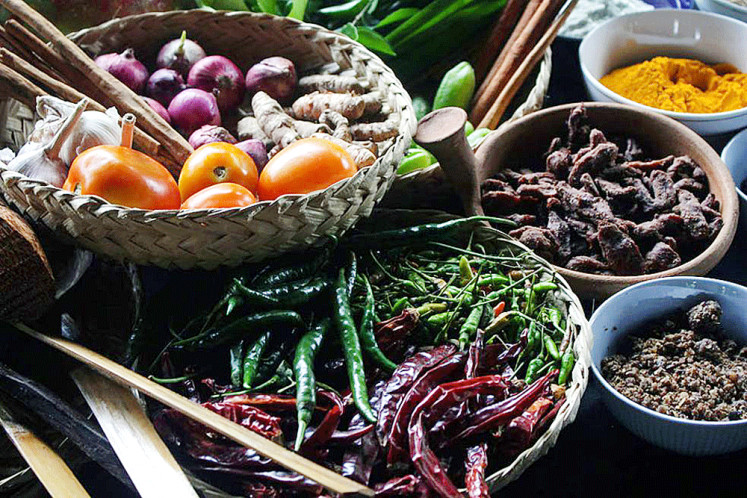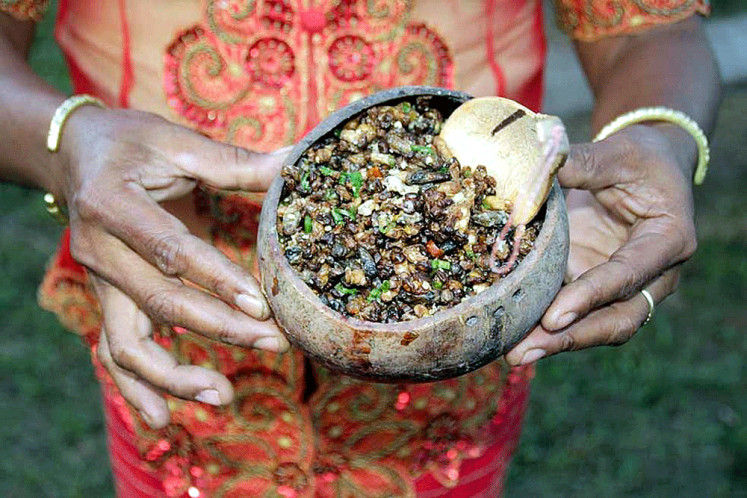Food is key to bringing people of different backgrounds and cultures together, as the Indonesian Culinary Photography Exhibition shows at the GoetheHaus in Central Jakarta.
The exhibition, which runs through Dec. 17, aims to raise awareness about the diversity of Indonesian cuisine and the importance of preserving it.
“We believe that preserving our culinary heritage strengthens us as a community, locally and globally,” said Wilton Djaya, content creator of the Goethe-Institut and a juror of the photo exhibition.
He said it was also important for Goethe-Institut to hold the exhibition, as food could be a medium of cultural exchange between Germany and Indonesia.
The exhibition features works curated from the institute’s Instagram competition on food photography held throughout the country. Fifteen photographs were selected from 321 submissions to portray Indonesia’s rich culinary diversity from Banda Aceh in Aceh to Timika in Papua.
More than just showcasing the food, these photographs also tell the stories behind the food and how these dishes are able to portray their culture of origin.
 Bumbu Masakan Aceh by Ade Armanda (Courtesy of Goethe-Institut Indonesien/-)
Bumbu Masakan Aceh by Ade Armanda (Courtesy of Goethe-Institut Indonesien/-)
“These 15 entries represent Indonesia — not only with good quality photographic esthetics, but also regarding high-quality storytelling,” said Wilton.
Curator Ng Swan Ti wants to give visitors a taste of what it feels like to explore and travel multicultural Indonesia through these unique photographs of each region’s signature dish.
One of the more interesting and powerful photos in the exhibit is Babi Bakar Batu (Stone-Roasted Pork) by Albertus Vembri, who goes by his second name.
The dish, which was photographed in the city of Timika, reveals the unique process behind its preparation. Unlike most roasting in which charcoal is used as main source of heat, babi bakar batu uses pre-heated stones.
Vembri explained that the use of stones was significant not only in cooking the dish, but that it also served as a ritual to express happiness or grief, or when people begin a new community project.
He agreed that a region’s cuisine portrayed its culture and values, a correlation that was particularly evident in the cooking tradition of babi bakar batu.
 Luat Sarang Lebah (Kupang, East Nusa Tenggara) by Silvania Stella Epiphania Mandaru (Courtesy of Goethe-Institut Indonesien/-)
Luat Sarang Lebah (Kupang, East Nusa Tenggara) by Silvania Stella Epiphania Mandaru (Courtesy of Goethe-Institut Indonesien/-)
“Cuisine is interconnected to culture,” Vembri said over phone. “Babi bakar batu shows how people are able to work together as communities — which community provides what ingredients, which community plays what role. They all work together and in the end, they enjoy the food together. It shows their togetherness, since babi bakar batu is never prepared by just one or two people.”
Another interesting photo is Luat Sarang Lebah (Beehive “Expectorate”) by Silvania Stella Epiphania Mandaru.
Stella describes luat sarang lebah as a high-protein chili sauce made from bee larvae that is consumed at various events in the village of Amfoang in Kupang, East Nusa Tenggara.
Like the other photos, Luat Sarang Lebah does not only reveal the dish’s uniqueness as a cuisine but, most interestingly, showcases the ritual surrounding the dish’s preparation.
In harvesting the honeycomb, the villagers of Amfoang “sing” poetry to lull the queen bee into surrendering the honey willingly. In the description accompanying her photograph, Silvania said the ritual was performed because the people of Amfoang believed bees should be treated like beautiful women.
 Nasi Sayur Lodeh Ikan Tongkol (Malang, East Java) by Desy Bariyyatul Qibtiyah (Courtesy of Goethe-Institut Indonesien/-)
Nasi Sayur Lodeh Ikan Tongkol (Malang, East Java) by Desy Bariyyatul Qibtiyah (Courtesy of Goethe-Institut Indonesien/-)
Another photo, Bumbu Masakan Aceh (Aceh Seasonings) by Ade Armanda, captures the spices typically used in Acehnese dishes. The photograph portrays a vast array of the daily ingredients the people use in the region, which is known for its rich spices and spicy foods.
Ade also provides a historical context for his photograph, explaining how Aceh used to be a hub of foreign trade and how it influenced the wide range of spices that are used in Acehnese dishes, even today.
As part of the exhibit, the jury selected the five best photographs from those on display.
Wilton said the jury was given different sets of criteria to assess the entries, such as original idea, storytelling and esthetics as well as whether the ingredients were indigenous to a remote area and whether the food would be appealing to the Goethe-Institut’s target group.
The five winners would receive awards, including dining at Goethe’s Magic Hour Dinner, an exclusive dinner event hosted by German chef Helge Hagemann and Indonesian chef Petty Elliott at a pop-up restaurant at Goethe-Institut Jakarta.
As the curator of the exhibition, Swan Ti said she also learned about how rich and diverse Indonesia’s culinary traditions were. “There were several foods that I was not familiar with before,” she said, adding that she hoped visitors to the exhibit would also learn something similar.
— The writer is an intern at The Jakarta Post.
https://www.thejakartapost.com/life/2018/12/11/indonesias-diversity-through-food-photography.html
0 Comments:
Post a Comment